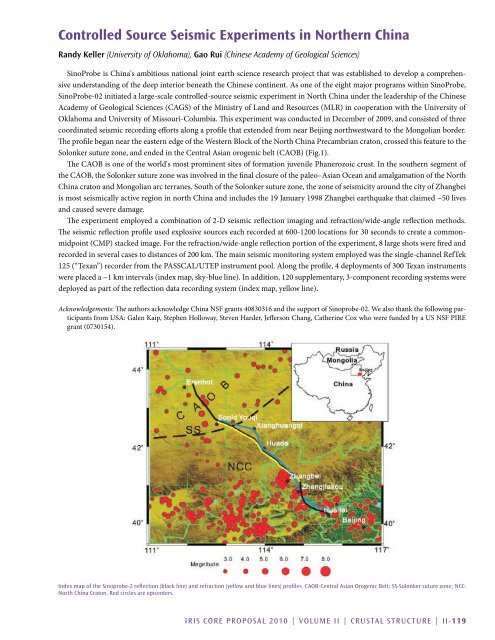Accomplishments - IRIS
Accomplishments - IRIS
Accomplishments - IRIS
You also want an ePaper? Increase the reach of your titles
YUMPU automatically turns print PDFs into web optimized ePapers that Google loves.
Controlled Source Seismic Experiments in Northern China<br />
Randy Keller (University of Oklahoma), Gao Rui (Chinese Academy of Geological Sciences)<br />
SinoProbe is China's ambitious national joint earth science research project that was established to develop a comprehensive<br />
understanding of the deep interior beneath the Chinese continent. As one of the eight major programs within SinoProbe,<br />
SinoProbe-02 initiated a large-scale controlled-source seismic experiment in North China under the leadership of the Chinese<br />
Academy of Geological Sciences (CAGS) of the Ministry of Land and Resources (MLR) in cooperation with the University of<br />
Oklahoma and University of Missouri-Columbia. This experiment was conducted in December of 2009, and consisted of three<br />
coordinated seismic recording efforts along a profile that extended from near Beijing northwestward to the Mongolian border.<br />
The profile began near the eastern edge of the Western Block of the North China Precambrian craton, crossed this feature to the<br />
Solonker suture zone, and ended in the Central Asian orogenic belt (CAOB) (Fig.1).<br />
The CAOB is one of the world's most prominent sites of formation juvenile Phanerozoic crust. In the southern segment of<br />
the CAOB, the Solonker suture zone was involved in the final closure of the paleo–Asian Ocean and amalgamation of the North<br />
China craton and Mongolian arc terranes. South of the Solonker suture zone, the zone of seismicity around the city of Zhangbei<br />
is most seismically active region in north China and includes the 19 January 1998 Zhangbei earthquake that claimed ~50 lives<br />
and caused severe damage.<br />
The experiment employed a combination of 2-D seismic reflection imaging and refraction/wide-angle reflection methods.<br />
The seismic reflection profile used explosive sources each recorded at 600-1200 locations for 30 seconds to create a commonmidpoint<br />
(CMP) stacked image. For the refraction/wide-angle reflection portion of the experiment, 8 large shots were fired and<br />
recorded in several cases to distances of 200 km. The main seismic monitoring system employed was the single-channel RefTek<br />
125 (“Texan”) recorder from the PASSCAL/UTEP instrument pool. Along the profile, 4 deployments of 300 Texan instruments<br />
were placed a ~1 km intervals (index map, sky-blue line). In addition, 120 supplementary, 3-component recording systems were<br />
deployed as part of the reflection data recording system (index map, yellow line).<br />
Acknowledgements: The authors acknowledge China NSF grants 40830316 and the support of Sinoprobe-02. We also thank the following participants<br />
from USA: Galen Kaip, Stephen Holloway, Steven Harder, Jefferson Chang, Catherine Cox who were funded by a US NSF PIRE<br />
grant (0730154).<br />
Index map of the Sinoprobe-2 reflection (black line) and refraction (yellow and blue lines) profiles. CAOB-Central Asian Orogenic Belt; SS-Solonker suture zone; NCC-<br />
North China Craton. Red circles are epicenters.<br />
<strong>IRIS</strong> Core Proposal 2010 | Volume II | Crustal Structure | II-119

















